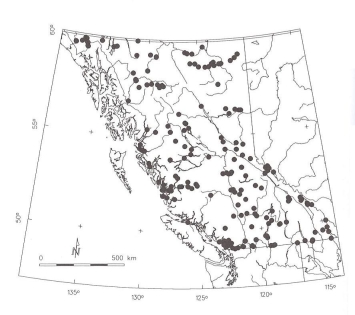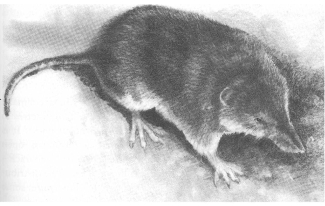The length of the breeding season in British Columbia is unknown. Data from museum specimens indicate that breeding females have been found from May to September. In eastern North America, the breeding season is generally from April to October; and in populations with abundant food resources, it may extend into November. Average embryo counts reported for various populations across North America range from five to eight. Females can produce at least two litters in a breeding season. Although uncommon, males and females may breed in their first summer. Newborn Common Shrews weigh 0.2 to 0.3 grams and are only 12 to 14 millimetres long. They grow quickly, attaining adult size in 20 to 27 days when they leave the nest.
|
Prey identified in the stomachs of the Common Shrew include: insect larvae, ants, beetles, crickets, grasshoppers, spiders, harvestmen, centipedes, slugs, snails and fungi. Seeds may also be consumed in winter. The Common Shrew's diet is very flexible, and because of its broad range this species demonstrates considerable geographic variation in diet. A study in Michigan revealed that ants were the major prey, representing 50 per cent of the food items; in New Brunswick, insect larvae were recorded as the predominant prey type. Common Shrews associated with Tamarack bogs in Manitoba fed almost entirely on Larch Sawfly larvae in late summer. A population living on a small island in Nova Scotia hunted mainly in the intertidal zone where they fed on kelp flies and marine amphipods.
Charles Buckner saw two Common Shrews hunting butterflies during the day. Darting quickly towards their prey, the shrews leaped into the air to pounce on the butterflies before they could take flight. They ate only the bodies of the butterflies and discarded the wings. An observation by Otto Horvath of Common Shrews raiding a Solitary Vireo nest 1.7 metres above ground suggests that some will hunt in shrubs and trees.
|
An abundant species, the Common Shrew is the dominant shrew species in many communities. In Manitoba, Charles Buckner estimated population densities of 5 to 22 per hectare in bog habitats. Nevertheless, abundance varies extensively among habitat types and pronounced population fluctuations occur from year to year that may be related to variations in the abundance of prey. The Common Shrew readily exploits habitats disturbed by fire or logging. Walt Klenner found this shrew in all his forest study plots in the Thompson Plateau, from uncut stands to recent clearcuts. The average home range is about 0.6 hectares.
The Common Shrew is active for very short periods (about two minutes) throughout a 24-hour period. Its peak activity is after dark, and activity is greatly increased when there is a night-time rainfall. Most activity is associated with feeding; captive Common Shrews, observed for a week, fed about every 13 minutes.
Less than half the young will survive beyond five months. The maximum life span is about 15 months, although a few individuals may reach two years of age.
|
|


